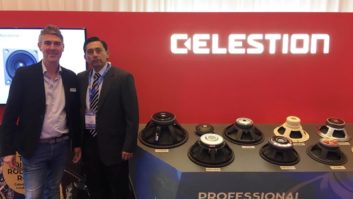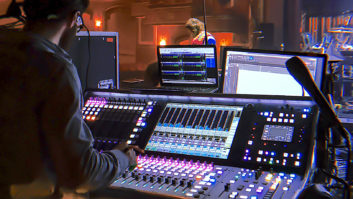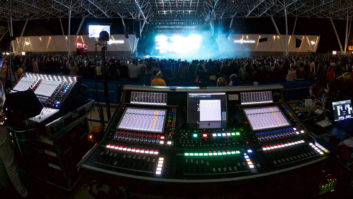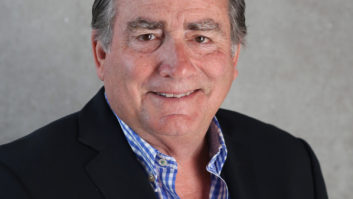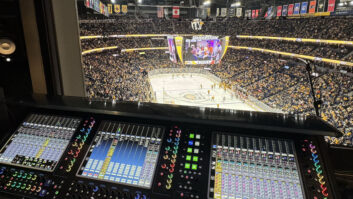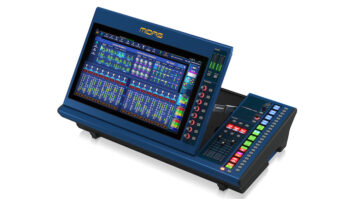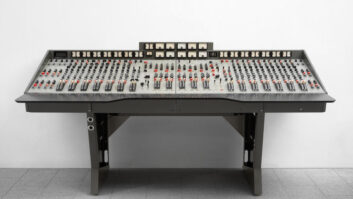With the popularity of multi-act musical events at an all-time high, mixing console needs at FOH and monitor positions are broader and more complex than ever. After all, many festivals host dozens of acts, and thus dozens of different engineers, each of which will have unique preferences and mixer requirements.
“Festivals obviously present engineers with some unique challenges, especially when not carrying their own desks,” offers Derk Hagedorn, Avid senior marketing manager for live sound systems. “Limited time for sound checks and tight switchovers between acts necessitate that engineers need to be able to quickly get up and running on whatever system is provided. Over the past ten years, Avid’s Venue consoles—especially the Venue Profile system—have become ubiquitous at festival FOH positions, as almost every engineer has mixed on a Venue system at some time and most have a Venue show file on a USB drive that they can quickly load.”
So, what exactly are among the most popular choices in festival mixing today, based on the observations of audio system providers?
“As far as consoles, Avid is still a dominator in the market, with DiGiCo a close second,” responds Bryan Baumgardner, operations and logistics for Clearwing Productions. “Feature-set file compatibility is key, especially for fluidity of rental inventory—using what we have available. Avid show files work between D-Show, Profile and SC48 as well as mostly S3L and S6L. DiGiCo SD-Series consoles are fully cross-compatible using the SD-CONVERT software. So, by a long shot, the market is still dominated by Avid Profile and DiGiCo SD10, 5 and 7, with the S6L and Solid State Logic’s Live platform becoming increasingly popular.”
“Consoles that we see are popular and accepted for festivals are the Avid Profile, DiGiCo SD10, and the Midas Pro2,” offers Daniel Villegas, vice president of Operations of Los Angeles-based Harmony Event Productions. “With that said, we used to choose the production console based off what files most FOH engineers are traveling with for the acts participating in that festival. As our company has grown and the festivals we provide sound for have grown, we find that our festival engineers often look for a solid copy-and-paste feature and customizable input output faders, as well as the ability to move channel faders with ease.”
“When Allen & Heath’s dLive hit the market, we began to supply festivals with dLive S5000 and S7000s,” continues Villegas. “We did this because we found dLives provide our festival engineers with those features as well as stellar sound quality…. When the dLive is put up side by side with previous consoles of choice at a festival, it’s amazing to see peoples’ astonished reaction to the dLive’s sound and functionality. If placed on monitors, the dLive makes setup and multi-band mixing a breeze. Putting the console on a network and using the iPad to notch problem frequencies out add to the already high functionality speed of the console. The customizable fader banks make it easy for our monitor engineers to accommodate every band from festivals’ start to finish.”
Also popular in festival settings are Yamaha’s broad range of live mixing solutions, as Yamaha’s notable workflow is widely understood by most of today’s working live engineers. “Most engineers would agree that Yamaha consoles have a very intuitive user interface—very important in a festival situation,” offers Marc Lopez, director of marketing, commercial audio products, Yamaha Professional Audio. “There are many operational paradigms that have remained consistent throughout our 30 years of designing digital mixers, and many useful improvements such as online/offline editor software, flexible patching, and iPad control, to name a few. These designs and improvements make Yamaha consoles a steadfast choice for any mix situation. For the past 15 years, we have been offering a hands-on training program originally conceived to usher engineers into the digital age, and now, into the networking era. A great balance of reliable, consistent product and an established training and support system, makes a successful formula for a festival-friendly console.”
Nashville-based Morris Light & Sound provided audio for four stages at this year’s CMA Festival, offering Nexo STM line arrays paired with Yamaha consoles—notably including the recent flagship Rivage PM10—monitors and more for the four-day festival. “The guys at Morris had a solid file built ahead of time on the Yamaha PM10, and after getting my bearings of the desk’s layout, it was smooth sailing,” said David Loy, FOH engineer for artist Kane Brown. “Personally, I appreciated several features: The console’s expanded channel section was a familiar sight for my eyes and extremely helpful. Having every controllable parameter of a channel just an arm’s reach away was perfect for the festival situation where speed was key. Using the Rupert Neve Designs Silk, I dialed in the Blue Silk transformer on my drums and bass while adding the Red Silk circuit on my guitars and Kane’s vocal. Immediately, the harmonic relationship between my kick and bass was so smooth; my lead vocal shined and was just how I needed Kane’s voice to sound. Since he jumps so much between his baritone to tenor ranges, the Red Silk circuit really helped emphasize some of those characteristics of his voice at all times that I would typically have to get with EQ. But instead with the PM10, I was able to get those aspects just with one knob. It was stellar.”
Depending on the musical styles featured in a given festival, console needs and requirements may vary. “For smaller acts—van/trailer types—the [Behringer] X32/M32 platform is widely used,” explains Baumgardner. “Rock/metal festivals are also dominated by X32/M32 as well as largely the Midas Pro series. Interestingly enough, a lot of the more ‘trendy’ acts are going back to analog—API Paragons, Midas XL4s, H3000s, etcetera. Certain EDM acts require [Yamaha] PM5Ds; however, that market is still largely dominated by Avid Profiles. The ‘general’ broader scope of acts are on DiGiCo or Avid, as mentioned before. And finally, with ‘A list’ acts, you can almost assume it will be a DiGiCo SD7. We often find the best combo for festivals is just to put an SD10 and a Profile in each position paired with a ‘festival’ desk of some sort at FOH, like a DiGiCo S21 or Midas Pro1 to handle DJ/MC/Video and so on.”
Meanwhile, Villegas wisely offers the following: “Regardless of the genre of music being mixed, sound quality of the mixing desk should always be top notch.”
Agreeing, FOH engineer Drew Thorton—also of Harmony Event Productions—attests that any good mixer can (and should) be workable regardless of genre.
“Compressors do tend to change things a bit from desk to desk,” he admits. “And I do feel like any aggressive music such as rock or some pop bands require more of an edge, so having some kind of fast and punchy compression helps. Some other genres may be complemented with a more open and round sound. Simply put, the diversity in stock compression is what can make our jobs easier to slip from genre to genre in a fast-paced festival setting.”
Regarding how recent festival engineers seem to thrive with particular consoles, Baumgardner explains Clearwing’s shipment of DiGiCo mixers to the Summerfest Festival and B96 Summer Bash, respectively. “We use DiGiCo everywhere,” he offers, “then we supplement other consoles as needed. Although putting SD10s and Profiles in both positions at festivals is the easy thing to do, the budget doesn’t always permit it. In that case, we pick one flavor, and try to negotiate to have all artists use that. At quick-turn festivals—like B96 Summer Bash, which has basically no changeovers—there is a DiGiCo and a Profile at both ends of the snake.”

A bevy of DiGiCo consoles await shipment to the Summerfest Festival from Clearwing Productions in Milwaukee, WI.
“Long billed as the ‘World’s Largest Music Festival,’ Summerfest brings in nearly a million visitors to see and hear more than 800 acts performing over an 11-day run,” explains Clearwing Productions’ president and CEO Gregg Brunclik. “Clearwing has been providing audio for Summerfest since 1995, and it’s a fast-paced, punishing schedule of amazing artists, rain or shine. We’ve been increasingly relying on DiGiCo consoles for more and more stages each year, and we’re thrilled to now finally have them on every single Summerfest venue. Why? Because they’re without a doubt the most requested console brand on touring riders, their reliability has been absolutely rock-solid, and the service and support we’ve received from DiGiCo’s distributor, Group One, has been second to none. Period.”
“For multi-act festivals, a console with superb functionality as well as great sound quality is what we look to provide our clients,” says Villegas for his frequent choice of Allen & Heath’s dLive. “During festivals, the sound team is always under a time crunch. That is why we always provide a console that allows the show to run as smooth as possible and sound the best at the same time. Therefore, we chose the dLive for this year’s Music Tastes Good Festival, One Love Reggae Fest, for When We Were Young Fest, and will continue to do so at our upcoming festivals.”
“Mixing multiple bands, or even hosting multiple engineers, you do really need the flexibility to change things up quick and fast,” concludes Thorton. “Every single engineer does things differently and I will say that it always makes things easier to mix when you know where everything is.”
